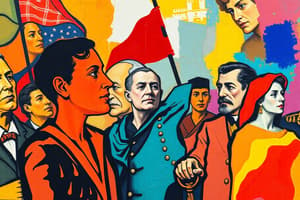Podcast
Questions and Answers
What is suffrage?
What is suffrage?
- An ideal society
- A system where members of Congress choose the party's candidate
- The practice of giving people government jobs based on party loyalty
- The right to vote (correct)
What is the spoils system?
What is the spoils system?
The practice of giving people government jobs on the basis of party loyalty
What is the caucus system?
What is the caucus system?
A nomination system in which the members of the party who are serving in Congress choose the party's candidate.
What was the Tariff of Abominations?
What was the Tariff of Abominations?
What does it mean to secede?
What does it mean to secede?
Who was Daniel Webster?
Who was Daniel Webster?
What was the Force Bill?
What was the Force Bill?
What was the Indian Removal Act?
What was the Indian Removal Act?
What was the Trail of Tears?
What was the Trail of Tears?
What was the Panic of 1837?
What was the Panic of 1837?
What is nativism?
What is nativism?
What were the Know-Nothings?
What were the Know-Nothings?
What was the Second Great Awakening?
What was the Second Great Awakening?
Who was Charles Grandison Finney?
Who was Charles Grandison Finney?
Who was Joseph Smith?
Who was Joseph Smith?
What is a utopia?
What is a utopia?
What is romanticism?
What is romanticism?
What is transcendentalism?
What is transcendentalism?
Who was Dorothea Dix?
Who was Dorothea Dix?
Who was Lyman Beecher?
Who was Lyman Beecher?
What is a benevolent society?
What is a benevolent society?
What is temperance?
What is temperance?
What is a penitentiary?
What is a penitentiary?
Who was Horace Mann?
Who was Horace Mann?
Who was Elizabeth Cady Stanton?
Who was Elizabeth Cady Stanton?
What was the Seneca Falls Convention?
What was the Seneca Falls Convention?
What was the American Colonization Society?
What was the American Colonization Society?
What is abolition?
What is abolition?
Who was William Lloyd Garrison?
Who was William Lloyd Garrison?
What is emancipation?
What is emancipation?
What was the American Anti-Slavery Society?
What was the American Anti-Slavery Society?
Flashcards are hidden until you start studying
Study Notes
Suffrage and Political Systems
- Suffrage refers to the right to vote, a key democratic principle.
- Spoils System involves granting government jobs based on political loyalty rather than merit.
- Caucus System is a nomination method where party members in Congress select their candidate.
Tariffs and State Rights
- Tariff of Abominations was passed in 1828, benefiting Northern manufacturing but deeply resented in the South.
- Secede means to formally withdraw from the Union, often referenced in the context of Southern states.
- Force Bill empowered the federal government to collect tariffs by force if necessary.
Native American Policies
- Indian Removal Act of 1830 authorized the relocation of Native Americans east of the Mississippi River.
- Trail of Tears describes the forced 800-mile march of the Cherokee to Indian Territory (1838-39), resulting in significant suffering.
Economic Challenges
- Panic of 1837 was an economic depression triggered by President Jackson's policies, leading to bank closures and high unemployment.
Social Movements
- Nativism embodies hostility toward immigrants, driven by fear of foreign influence.
- Know-Nothings were an anti-immigrant political group active during the 1840s and 1850s, also known as the American Party.
- Second Great Awakening was a 19th-century religious revival emphasizing personal responsibility and societal improvement.
- Charles Grandison Finney was a prominent preacher in the revivalist movement, advocating for social reform.
Religious and Utopian Movements
- Joseph Smith founded the Mormon Church in 1830, significantly impacting American religion.
- Utopia refers to the concept of an ideal society, often sought in various reform movements.
- Romanticism focused on emotion, individualism, and nature, a reaction against industrialization in the late 1700s.
- Transcendentalism encouraged individuals to go beyond the limits of their minds to appreciate the beauty of existence.
Reform and Education
- Dorothea Dix campaigned for the care of the mentally ill and prison reform in the U.S.
- Lyman Beecher was a Presbyterian minister influential in the temperance movement and the Second Great Awakening.
- Benevolent Societies were community organizations formed to assist immigrants and promote social welfare.
- Temperance advocates called for moderation or complete abstinence from alcohol.
Criminal Justice and Education
- Penitentiary facilities were based on the idea that inmates could reform through reflection.
- Horace Mann was a pioneer in educational reform, serving as the first secretary of the Massachusetts Board of Education.
Women's Rights and Abolition
- Elizabeth Cady Stanton was a leader in the women's suffrage movement, co-organizing the Seneca Falls Conference in 1848.
- Seneca Falls Convention marked a significant moment for women's rights, presenting the Declaration of Rights and Sentiments.
- American Colonization Society sought to end slavery by relocating free blacks to Africa, resulting in the creation of Liberia.
- Abolition was a movement aimed at ending slavery in the United States.
- William Lloyd Garrison was a notable abolitionist advocating for immediate emancipation and the separation from Southern states.
- Emancipation signifies the liberation of all enslaved individuals.
- American Anti-Slavery Society was founded in 1833 by Garrison, promoting the immediate abolition of slavery with widespread membership by 1838.
Studying That Suits You
Use AI to generate personalized quizzes and flashcards to suit your learning preferences.




